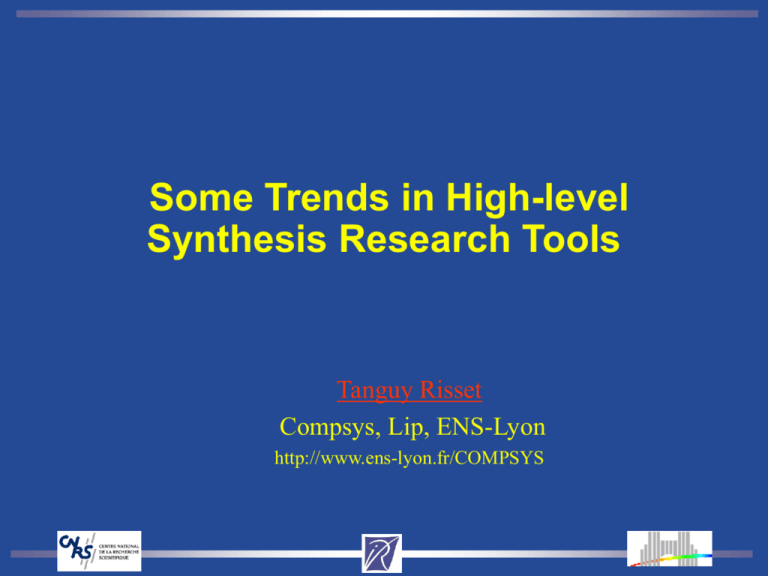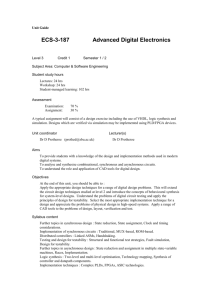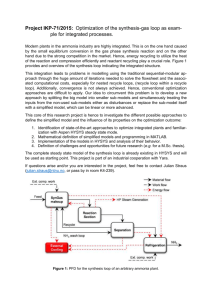High level synthesis tools
advertisement

Some Trends in High-level
Synthesis Research Tools
Tanguy Risset
Compsys, Lip, ENS-Lyon
http://www.ens-lyon.fr/COMPSYS
Outline
• Context: Why High level synthesis?
• HLS Hard problems
• Some solution in existing tools
• Some on-going projects
2
Context: Embedded Computing
Systems design
• SoC or MPSoC for multimedia application will soon
includes:
Network on chip
dozens of initiators (CPU, DMA,…)
Mbytes of code
Operating systems
Shared memory coherency protocols
…
• SoC Design problems:
Time to market
Design space exploration
Software complexity
3
Some envisaged solutions
• Time to market
IP re-use
High level design
• Design space exploration
Fast prototyping and performance evaluation, refinement
methodology (specification, algorithm, TLM, CABA)
• Software complexity
Tools for embedded code generation/embedded OS
• High level synthesis is only a small part of the « High level
Design » process
4
Definition of High Level Synthesis
• HLS: Generates register-transfer level description from
behavioral specification, in an automatic or semi-automatic
way.
• Input:
A behavioral specification
Design constraints
Library of available RTL components
• Output:
RTL description
Performance evaluations
5
Refinement : from algorithm to hardware
algorithm
domain
Transaction
Level
Modeling
algorithmic exploration
abstract architecture
• Matlab
•C
System
application design
• SoC Intermediate Representation
SoC platform design
virtual prototype
Architecture
Description
Language
block specification
IP block design
block implementation
• RTL Synthesis,
Synthesis VHDL, Verilog
6
Abstraction levels for HLS
• AL
• TLM
• T-TLM
• CABA
• RT
= Algorithm
prior to HW/SW partition
= Transaction-Level Model
after HW/SW partition
models bit-true behavior, register bank,
data transfers, system synchronisation
no timing needed
= Timed TLM (also PVT)
TLM + timing annotation
refined communication model
= Cycle Accurate-Bit Accurate
models state at each clock edge
= Register Transfer (ASIC flow entry point)
synthesisable model
7
Pro’s and Cons
• « Traditional » motivations:
Fast design
Safe design : formal refinement approach
« Must be used » to cope with Moore’s law
• But!
Commercial tools are not here
A new tool is a big investment
Designers have managed without it
8
New motivations ?
• IP-reuse
Slightly change design parameter for re-using IP
• New target technologies and languages (FPGA, SystemC,
etc.)
Tools can easily re-target the designs
• CAD tools companies are investing a lot in « high levellike » synthesis tools
Monet, Behavioural compiler, VCC, …
• Technological advantage
Traditional RTL design will be de-localized to Asia
9
Outline
• Context: Why High level synthesis?
• HLS Hard problems
• Some solution in existing tools
• Some on-going projects
10
HLS Hard Problems
• Huge design space
Complex design space exploration
Multi-criteria optimization techniques
• Integration into a design environment
Lack of standard interchange format
SoC simulation time is a crucial issue
• Acceptance by the designers
Find a language common to SoC designers and tools designer
• Refinement technical problems
(detailed hereafter)
11
HLS technical problems
• Compilation occurs when the target architecture is
precisely known
• In HLS, target architecture is only partially specified,
Examples:
Data-flow architecture/systolic arrays : pure RTL description
FSM+data path : closer to processor description
• HLS technical problems :
Initial specification format / language
Specification refinement : fixed point arithmetic
Scheduling/Mapping refinement: resource constraints
Technological Mapping refinement
12
Initial specification format
• Restriction on the input language expressivity are necessary
• … but designers hate new languages
• C-like language (handel-C, silicon-C,hardware-C, etc…) are actually
hardware description languages
• Main problems:
How to express parallelism/sequentially
- Data-flow, CSP-like, process network, event-driven
How to express both algorithmic and RTL description
How much expressivity
- Dynamic control, loops
How to introduce constraints/hints
13
Fixed point arithmetic
• Problem: translate a floating point computation to fixed
point computation
• Most of the tools start with an initial fixed point
specification found by extensive simulation.
• Automatic techniques are not handling loops
• In the case of signal processing application the signal
processing theory can help (transfer function used to
compute signal-to-noise ratio).
14
Scheduling/Mapping
• For a « basic bloc », resource constraints scheduling is NP-Hard, but
widely studied.
• Computations
Currently, two way to handle loops:
- Unroll them
- Keep them sequential
Other solutions:
- Use software pipelining theory
- Use the polyhedral model
• Memory and communication
Memory mapping is usually strongly guided by the user
- Highly active research field (Catthoor, Darte)
Communication refinement is also an important issue
- Highly dependent on the chosen computation model (Gajski, Kenhuis)
15
Technological mapping refinement
• Fine technological mapping are very target-dependent
• Predefined libraries are not precise enough
Delays on wires
Power consumption
• VLSI designers « tricks » are difficult to integrate in tools
• Sub-Micronics technologies constraints are changing too
fast for high level tools
Cross talk
Capacitance
16
Outline
• Context: Why High level synthesis?
• HLS Hard problems
• Some solution in existing tools
• Some on-going projects
17
Some solution in existing tools
• Digital signal processing circuits:
Gaut: http://lester.univ-ubs.fr:8080
Source: signal processing (one infinite loop)
Target: RTL + FSM
• FSM+datapath
Ugh: http://www-asim.lip6.fr/recherche/disydent/
Source: restricted C
Target: FSM+data path
• Regular computation and polyhedral Model
MMAlpha: http://www.irisa.fr/cosi/ALPHA/
Source : functional specification
Systolic like architectures
18
GAUT:Génération Automatic
d’Unité de Traitement
• Developed first at LASTI (Lannion) and then LESTER (Lorient): free
• Generate RTL description from behavioral description for signal
processing algorithm
• Kernel technology: highly optimized ressource constraint scheduling
• Inputs are
- a behavioral VHDL description (one process repeated
infinitely)
- Libraries of operators pre-characterized
- Some design constraints
• Outputs are
- a synthesizable RTL VHDL description (data path, memory,
and communication units)
- Gantt chart for I/O specification
19
Gaut design flow
Behavioral description
VHDL
Compiling
-analyzing
-loop unrolling
.src
.lib
.gc
User constraints:
Latency, clock frequency
Operators, Alloc,etc.
.vhd
Operator library
RTL description
(data path+control)
graph
Synthesis
-selection
-Scheduling
Mapping
Memory and IO
specifications
.mem
20
Gaut : VHDL Input code
• Sequential instruction in one single process (no clock, no
reset, no sensitivity list)
ENTITY fir IS
PORT (xn:IN INTEGER; yn:OUT INTEGER);
END fir;
ARCHITECTURE behavioral OF fir IS
...
BEGIN
PROCESS
VARIABLE H,x:
vecteur;
VARIABLE tmp:
INTEGER;
VARIABLE i:
CONTROL;
BEGIN
tmp := xn * H(0);
FOR i IN 1 TO N-1 LOOP
tmp := tmp + x(i) * H(i);
END LOOP;
yn <= tmp;
FOR i IN N-1 DOWNTO 2 LOOP
x(i) := x(i-1);
END LOOP;
x(1) := xn;
WAIT FOR cadence;
END PROCESS;
END behavioral;
21
Gaut : Input code
• Types
Bit, boolean, std_logic, Integer (single size), Bit_Vector,
Std_Logic_Vector
Arrays (to be inlined)
• Sequential instructions
Signal and variables assignment
Only one level of if
For and While loops (to be inlined)
Procedure calls (to be inlined)
Function calls corresponding to library elements
22
Gaut step1: Source code
transformation
• Control dependence elimination
Loop unrolling
y ( 0 ) := x ( 0 ) * h ( 0 ) ;
for i in 1 to n - 1 loop
y ( i ) := y ( i - 1 ) + x ( i ) * h ( i ) ;
end loop ;
y ( 0 ) := x ( 0 ) * h ( 0 ) ;
y ( 1 ) := y ( 1 - 1 ) + x ( 1 ) * h ( 1 );
y ( 2 ) := y ( 2 - 1 ) + x ( 2 ) * h ( 2 ) ;
y ( 3 ) := y ( 3 - 1 ) + x ( 3 ) * h ( 3 ) ;
Procedure inlining
Static single assignment
b := x + z ;
a := b + c ;
b := e + f ;
y := b;
b := x + z ;
a := b + c ;
b0001 := e + f ;
y := b0001;
23
Gaut step1: Source code
transformation
• Simple expression generation
b := x + z * u ;
tmp := z * u ;
b := x + tmp ;
• Constant propagation
• Generation of GC Graph (Data-Flow Graph Format of Synchronous
Programming)
24
GAUT step 2: Scheduling/Mapping
• In addition to throughput and clock cycle, the user can
give:
Ressource constraints and mapping constraints
Memory constraints
I/O constraints
Optimization type
• The result is an architecture and a GANTT charts
For computations
For I/O
For memory
25
26
Gaut step 3: memory and
communication synthesis
• Optimizing memory layout and minimizing buses
I/O
Control
Datapath
Communication unit
Memory unit
27
Gaut: summary
• Advantages
Advanced development status (still research tool)
User guided synthesis
Open library
Active research team: memory optimization, communication
synthesis
• Drawbacks
Loop flattening (complexity problem)
Predefined timing characteristics
Hard to get out of 1D signal processing
28
Ugh: User Guided High Level
Synthesis
• Developed at LIP6 (Paris), as part of the Disydent project (Digital
System Design Environment): open source
• Behavioral level synthesis tool for control dominated coprocessor
• Emphasis on precise timing estimation
• Kernel technology: ressource constraint scheduling and (GNU-like)
compiler construction technology
• Inputs are
- a C or VHDL behavioral description with KPN
communication primitives
- a draft data-path
- a cycle time constraint TC
• Outputs are
- a synthesizable RTL VHDL model
- a cycle accurate simulation model
29
Coprocessor System Environment
R3000
Processor
ICacheDCache
Bus
Controller
unit
PI-BUS
M/S Interface
RAM
Coprocessor
30
UGH Structure
Cell
Library
Ugh C
Draft
Data-Path
Depends on the
Synthesis tool
(Synopsys)
Synthesis +
Characterization
Timing
Annotations
VHDL
Data-Path
UGH-CGS
Coarse grain scheduler
UGH-FGS
CK
Fine grain
scheduler
VHDL
FSM/C
VHDL
Data-Path + FSM
Caba simulation
Model
31
Input 1 : UGH-C
C Description
#include <ughc.h>
ugh_inChannel32 work2hcfa;
ugh_inChannel32 work2hcfb;
ugh_outChannel32 hcf2work;
uint32 a,b;
void hcf(void)
{
while (a != b)
if (a < b)
b = b - a;
else
a = a - b;
}
int ugh_main()
{
while (1) {
channelRead(work2hcfa,&a);
channelRead(work2hcfb,&b);
hcf();
channelWrite(hcf2work,&a);
}
}
•Library IEEE;
•Use
ieee.std_logic_arith.a
ll;
•entity HCF is
•port (CK
: in bit;
•
DINA : in integer;
•
READA : out bit;
•
ROKA : in bit;
•
DINB : in integer;
•
READA : out bit;
•
ROKA : in bit;
•
DOUT : out integer;
•
WRITE : out bit;
•
WOK
: int bit);
•end HCF;
32
Input 2 : Draft Data-path
model Hcf(sofifo hcf2work;
sififo work2hcfa,
work2hcfa)
{
DFFl a, b;
SUB subst;
a
D
Q
A
Subst
S
subst.A = a.Q, b.Q;
subst.B = a.Q, b.Q;
a.D
b.D
= subst.S, work2hcfa;
= subst.S, work2hcfb;
b
D
Q
B
hcf2work= subst.S;
}
33
OUTPUT 1 : Refined Data path
sel_m1
we_ra sel_m4 inf
RegA
dina
i0
z
d
q
i1
i0
z
i1
M4
M1
zero
co
a
z
Subst
s
M2
dinb
z
dout
M3
i0
d
q
i1
i0
z
i1
b op
RegB
ck
sel_m2 we_rb
sel_m3
op_subst
34
OUTPUT 2 : FSM for control
RESET
RESET
RESET
START
READY
WHILE
START
ROKA
ROKA
ROKB
IF
READA
READB
ROKB
S1
S2
WRITE
WOK
WOK
35
Ugh summary
• Advantages
Precise timing information
Multi cycle operation
Almost a compiler approach (restricted target architecture)
Interfacing (Integrated in a SoC design environment)
• Drawbacks
Development status (research tool)
Low level information given by the user
Highly dependent on commercial tool (synopsys)
Dedicated to control oriented applications
36
MMAlpha
• Developed in Irisa (Rennes): open source
• High level synthesis of highly pipelined accelerators
• Kernel technology: polyhedral model and systolic design
methodology
• Emphasis on loop transformations
• Input :
functional specification (Alpha langage)
• Output :
RTL description of systolic-like architecture (Alpha or VHDL)
37
MMAlpha design flow
FPGA
VHDL
Uniformization
Alpha
For i=1:1:N
For j=1:1:N
Scheduling
bus
VHDL
RTL derivation
host
C
C
C
C
38
What is polyhedral model?
• Abstract a loop nest by the polyhedron described by the
loop indices during execution of the loop
• Can be used for any index-based structure : memory
(arrays), communications (accesses), etc…
• example: convolution (FIR filter)
N 1
y(i)H(n)x(in)
n0
for (i=N; i<=M; i++) {
y(i)=0;
for (n =0; n<=N-1; j++)) {
y(i)=y(i)+H(n)x(i-n)
}}
39
FIR: iteration space
y(N+1)
n
y(N)
H(N-1)
H(0)
i
0 0
x(N) x(N+1)
40
FIR polyhedral representation
(MMAlpha input language)
i, n N i M ; 0 n N 1
Y[i,n] Y[i,n 1] H[n]*x[i-n]
y(N+1)
n
y(N)
H(N-1)
H(0)
i
0 0
x(N) x(N+1)
41
MMAlpha polyhedral scheduling
i,n NiM; 0nN1
Y[i,n]Y[i,n1]H[n]*x[i-n]
y(N+1)
n
y(N)
H(N-1)
H(0)
i
0 0
t=4 5
6
x(N) x(N+1)
42
MMAlpha space time transformation
t, p p t p N M ; 0 p N 1 Y[t,p] Y[t 1,p 1] H[p]*x[t-2 p]
y(N)
p
H(N-1)
H(0)
t
0 0
6
t=4 5
x(N) x(N+1)
43
MMAlpha mapping
t, p p t p N M ; 0 p N 1 Y[t,p] Y[t 1,p 1] H[p]*x[t-2 p]
y(N)
p
y
H(N-1)
H
H(0)
ti
0 0
x(N) x(N+1)
0
6
t=4 5
x
44
MMAlpha resulting architecture
x(n-2N+D+1)
x( n+D-1)
D-1
x( n)
d( n)
y( n)
w0
-
w1
w2
wN -1
x(n-2N+2)
wN-1
e(n-N+1)
+
e( n)
y( n)
p=0
p=1
p=N-1
45
MMAlpha current features
• Tool box for designers:
Powerful analyze tools
Pipelining, Change of basis, multi-dimensionnal scheduling,
control signal generation.
Code generation (C, VHDL)
Hierarchical design methodology
• Work in progress:
Ressource constraint scheduling (extention to Z-polyhedra)
Multi-dimensionnal scheduling and memory synthesys
46
MMAlpha summary
• Advantages
Design tool integrating loop transformation
Parameterised design (N: size of the filter not fixed until VHDL
generation)
Formal approach for refinement (functional to operational)
A real language that syntactically captures HLS input restriction
• Drawbacks
Does not yet handle resource constraints
A language (Alpha) and design methodology very different from
designer’s habits
Implementation status (research tool)
47
Some Design results
• Ugh compares IDCT with CoWare and Gaut but the results are highly
dependent upon design parameters
Ck period (ns)
#cycle
execution
Exec time
(µs)
Area (mm^2)
Area
(#inverter)
Manual (time
optimised)
10.41
118
1.228
N-A
242.1
CoWare
21
1 645
34.545
19.94
165.6
Gaut
17.5
526
9.2
19
123.5
Ugh
17
1 466
25.922
10.9
70.9
• MMAlpha demonstrates real implementation on FPGA co-processor
board (DLMS algorithm)
8 tap DLMS filter
Area
Clk cycle
Synthesis time
MMAlpha
2600 slices
35MHz
112 s
48
Outline
• Context: Why High level synthesis?
• HLS Hard problems
• Some solution in existing tools
• Conclusion and on-going projects
49
HLS conclusion
• HLS tools are not mature enough to produce the famous
« C-to-VHDL » magic tool
• Most tool designer agree that a highly « user guided »
approach is mandatory
• CAD tools are still actively developping tools (Mentor:
Catapult-C, CoWare: Cocentric….)
• Some progress have been made
Domain specific constraints are more clearly identified (control
oriented or data flow)
Interfacing is studied together with the synthesis
Fast simulation is an important issue addressed by HLS tools
50
On-going project: Data-Flow IP
interface
VCI
IN
CTRL
I_FIFO
1
I_FIFO
2
Generic
Network
input
patterns
VCI
output
patterns
O_FIFO
OUT
CTRL
O_FIFO
1
2
Dataflow Hardware Accelerator
• Gaut (Lester) and MMAlpha (Irisa, Lip) are developing a
common interface for their IPs (data-flow Ips)
51
On-going project: SocLib
• SocLib environment
Public domain systemC simulation models for SoC IP:
- Cycle-accurate hardware simulation
- TLM Simulation
VCI interconnection standard
French open academic initiative (should become European through
EuroSoc):http://soclib.lip6.fr/
• Typical platform:
prog.c
MIPS
MIPS
MIPS
MIPS
Cache
VCI
Cache
VCI
Cache
VCI
Cache
VCI
Bus / Network on chip (SPIN)
MIPS exec
GCC-MIPS
prog
RAM
prog
boot
TTY
ASIC
DMA
52
On-going project: Loop
transformation for compilation
• Unified loop nest transformation framework for optimization of
compute/data intensive programs (Alchemy Inria project: http://wwwrocq.inria.fr/~acohen/software.html).
• WRaP-IT: and Open-64/ORC Interface tool
53
Thanks
•
Slides with Help from Lester, LIP6
•
Here are some tools I did not talk about: Amical, Cathedral, High2, RapidPath, Flash, A/RT, Compaan,
Syndex, Phideo, Bach, SPARK, CriticalBlue, Chinook, SCE, CodeSign, Esterel, precisionC, Polis, Atomium, Ptolemy, HandelC, Cyber, Bridge, MCSE, Madeo, SpecC, and many more….
Any Questions ?
54






